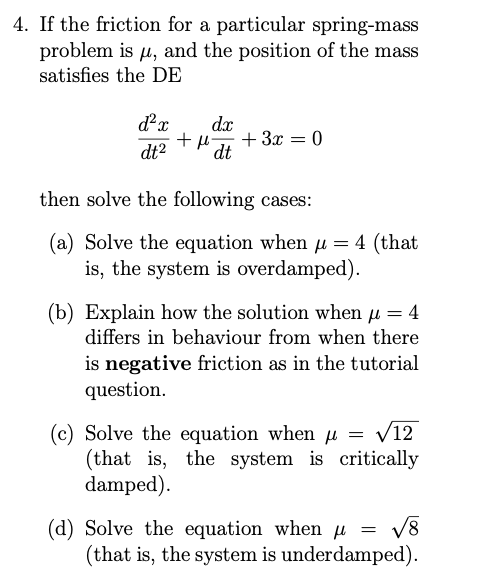4. If the friction for a particular spring-mass problem is µ, and the position of the mass satisfies the DE dx dt + µ- + 3x = 0 dt2 then solve the following cases: (a) Solve the equation when µ= 4 (that is, the system is overdamped). (b) Explain how the solution when µ = 4 differs in behaviour from when there is negative friction as in the tutorial question. (c) Solve the equation when µ = /12 (that is, the system is critically damped). (d) Solve the equation when µ = v8 (that is, the system is underdamped).
4. If the friction for a particular spring-mass problem is µ, and the position of the mass satisfies the DE dx dt + µ- + 3x = 0 dt2 then solve the following cases: (a) Solve the equation when µ= 4 (that is, the system is overdamped). (b) Explain how the solution when µ = 4 differs in behaviour from when there is negative friction as in the tutorial question. (c) Solve the equation when µ = /12 (that is, the system is critically damped). (d) Solve the equation when µ = v8 (that is, the system is underdamped).
Related questions
Question
question is attached below

Transcribed Image Text:4. If the friction for a particular spring-mass
problem is µ, and the position of the mass
satisfies the DE
dx
dt
+ µ-
+ 3x = 0
dt2
then solve the following cases:
(a) Solve the equation when µ= 4 (that
is, the system is overdamped).
(b) Explain how the solution when µ = 4
differs in behaviour from when there
is negative friction as in the tutorial
question.
(c) Solve the equation when µ = /12
(that is, the system is critically
damped).
(d) Solve the equation when µ = v8
(that is, the system is underdamped).
Expert Solution
This question has been solved!
Explore an expertly crafted, step-by-step solution for a thorough understanding of key concepts.
This is a popular solution!
Trending now
This is a popular solution!
Step by step
Solved in 5 steps
